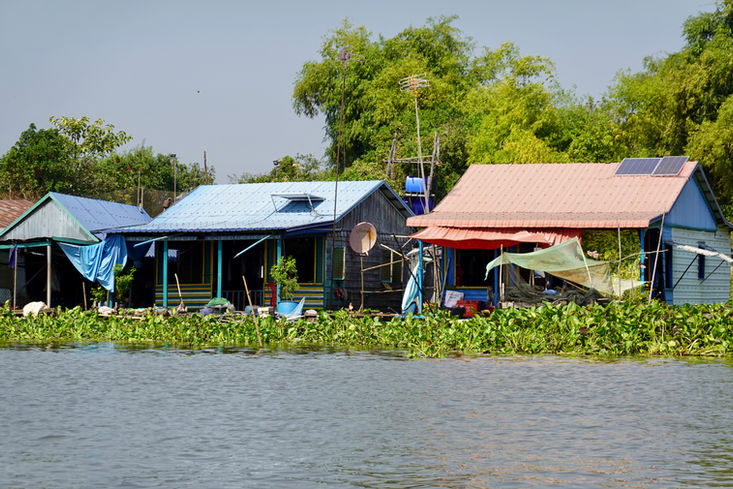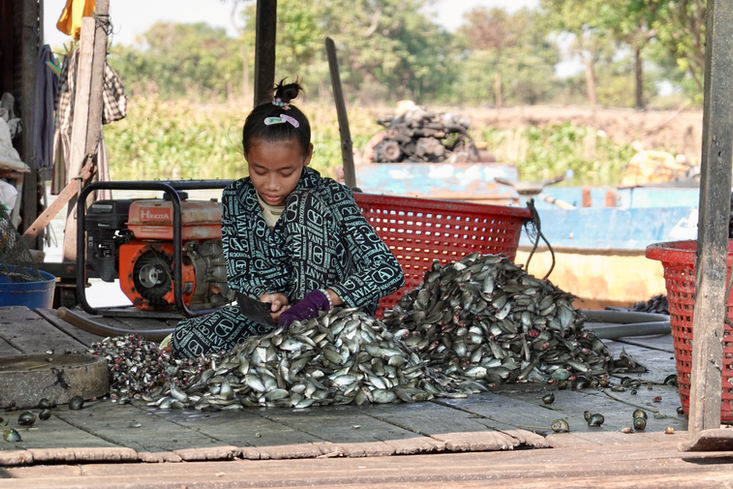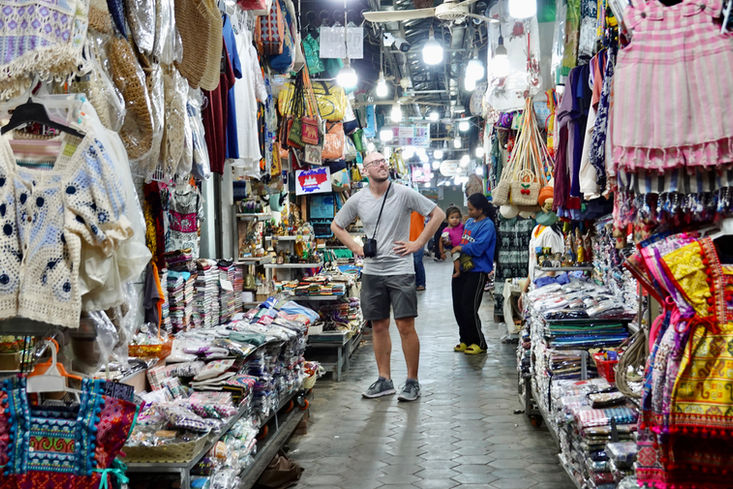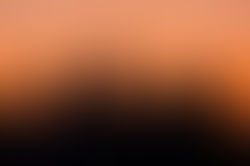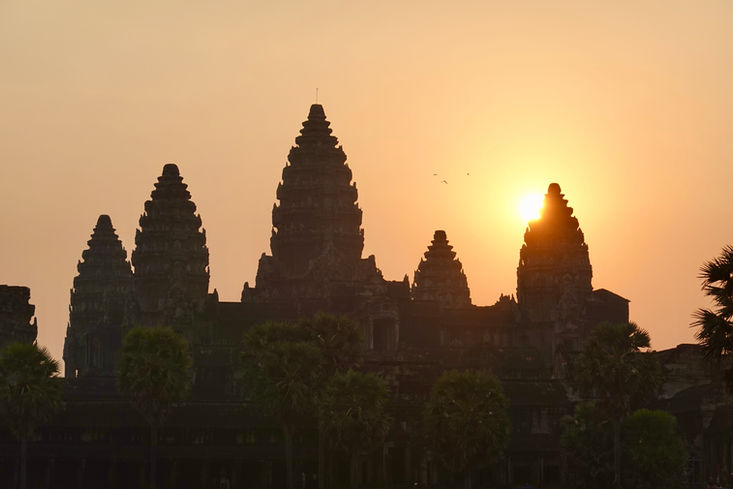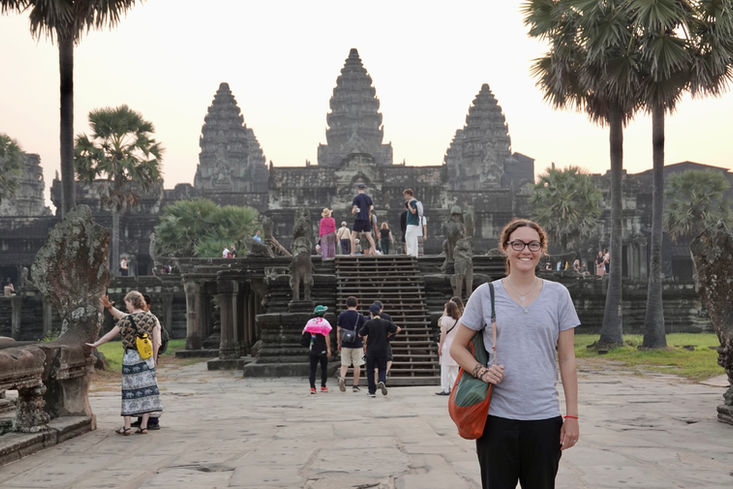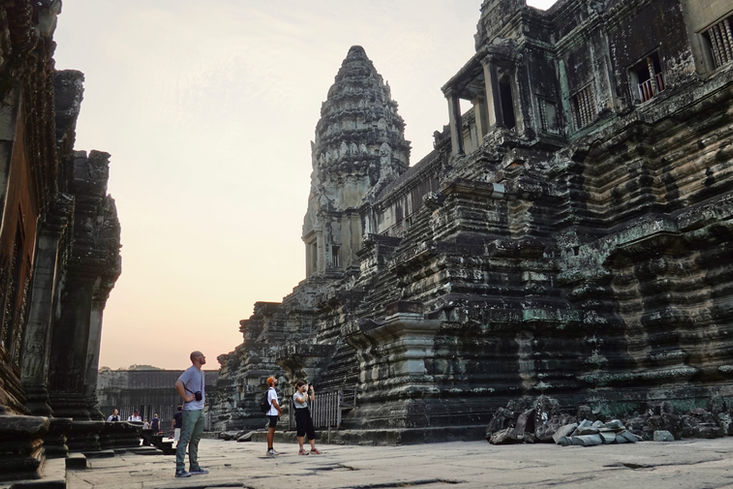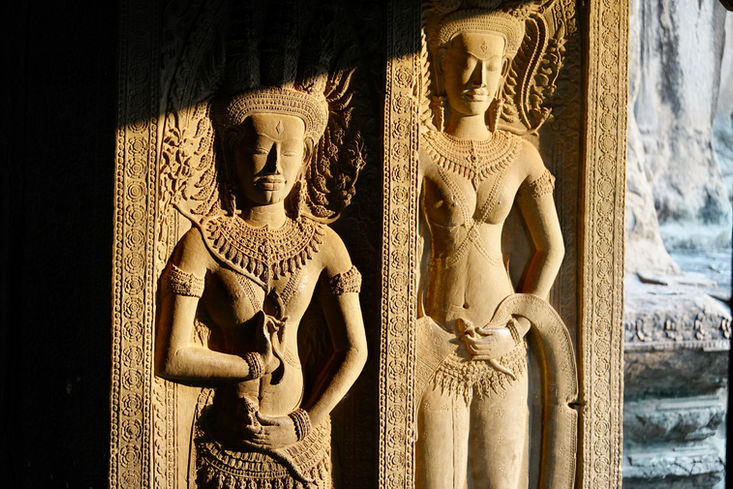
Cambodia
Last updated: February 2024
Overview:

If you are finding our content useful,
we would appreciate a donation via PayPal!
Key Facts Cycling
-
12 days in the country, from 27/01/2024 to 07/02/2024
-
555 km (345 mi) cycled
-
9 cycling days
-
Overnight stays:
-
Wildcamping: 0
-
Other free camping (villages, etc.): 0
-
Paid campsites: 0
-
Hosts: 0
-
Paid accommodation: 11
-
Other (bus, ferries, etc.): 0
-
-
The Route: Phsar Prum Border Checkpoint - Krong Pailin - Krong Battambang - Boat to Siem Reap - Banteay Srei - Svay Leu - Trapeang Prasat - Choam Ksant - Kampong Sralau - Anlung Chheuteal - Trapaingkriel Border Checkpoint
-
Our Cycling Highlights: Phnom Kulen National Park
Key Facts Country
-
Official name: Kingdom of Cambodia (ព្រះរាជាណាចក្រកម្ពុជា)
-
Population: 17 million
-
Capital: Phnom Penh
-
Official language: Khmer
-
Currency: Cambodian Riel (KHR) and, unofficially, US-Dollar (USD)
-
Dialing code: +855
-
Area: 181,035 sq km (69,898 sq mi)
-
Bordering countries: Thailand, Laos & Vietnam
-
Right-hand traffic
Phnom Kulen National Park

Cycling through impressive rock formations

The Kulen waterfall
-
A national park with lush forest, only ~50 km (30 mi) north of Siem Reap
-
Our main reason to cycle through there was the Poeng Ta Kho (Amazing Cliff)
-
The park also features the Kulen Waterfall
-
The road included some steep, but doable climbs (~12 %)
-
The road conditions were surprisingly good, in many parts the road was actually paved, and the unpaved parts were rather smooth to cycle as well
-
The scenery is beautiful, we cycled through dense forest (which also provided good shade in the heat) and past some impressive rock formations
-
The Poeng Ta Kho (Amazing Cliff) was definitely a highlight worth the climb
-
Generally, the park was busier and more touristy than we had expected though
-
Starting from around 9-10 am, more and more cars and mini buses started to drive past us, bringing tourists to the main attractions
-
It is also rather expensive to enter the park, 20 USD per person
-
The entry fee was, as far as we understood it, only for the Kulen Waterfall
-
Coming from Siem Reap, we had to pay the entrance fee at this location
-
When reaching the parking lot at the waterfall, we had to show our tickets
-
If we had known there would be another control, we would’ve asked if we could just cycle through without having to pay the fee, because we initially weren’t even planning on going to the waterfall
-
As we had already paid the entry fee though, we went to see it - beautiful, but way too touristy for our taste
-
-
As many other parts of Cambodia were rather flat and, honestly, a bit dull to cycle, we still don’t regret taking the road through the park
-
If you want to do this, we would advise you to come really early though, to avoid the people and especially the traffic
-
We actually cycled past several campsites, so you could also spend the night in the park
(Wild) Camping & Accommodation
-
From what we have read beforehand, there are no actual laws concerning wild camping in Cambodia, making it kind of a gray area
-
However, we didn’t camp even once while being in the country
-
We found accommodation to be so cheap and abundant that we didn't see the point in camping
-
We also didn't mind the shower every night after a long, sweaty cycling day ;)
-
Another reason against wild camping (in certain areas) are the millions of unexploded land mines still scattered throughout Cambodia, read more about it in Safety
-
Concerning accommodation, guest houses are a great option when arriving by bicycle, because the rooms are usually on the ground floor and most nights we were allowed to take our bikes with us into the room (if it was big enough)
-
Prices for accommodation are often stated in USD, which is a very common currency in Cambodia, apart from the official currency, the Riel (KHR)
-
We would advise you to always ask for the price in Riel (KHR), it’s often much cheaper than in USD
-
These are some examples of what we paid for accommodation per night:
-
15 USD for a nice, clean room with AC, WiFi, private bathroom, hot shower and an outdoor swimming pool, in a hotel/resort downtown in Siem Reap
-
60,000 KHR (= 14.50 USD, the price in USD would have been 18.50) for a simple, but clean and big room with AC, WiFi, private bathroom and hot shower, in a homestay near Banteay Srei (a sheltered camp spot on a wooden platform would have been available for 5 USD as well)
-
50,000 KHR for a simple, but clean and big room with AC, WiFi, private bathroom and hot shower, in a guest house in Svay Leu
-
20,000 KHR for a simple and not very clean room with fan, WiFi, private bathroom (without a sink though) and hot shower, in a guest house in Trapeang Prasat
-
45,000 KHR for a simple, but clean room with AC, WiFi, private bathroom and cold shower, in a guest house in Choam Ksant
-
60,000 KHR for a nice, clean room with AC, private bathroom and hot shower (no WiFi though), in a guest house in Anlung Chheuteal
-
-
In many guest houses they will tell you two prices (these are the price ranges we experienced):
-
20,000 - 30,000 KHR for a room with fan
-
40,000 - 60,0000 KHR for a room with AC
-
Usually every room has both, you just don’t get the remote for the AC if you don’t pay extra for it
-
-
The price differences between touristy and rural areas weren’t as big as we would have expected, especially when going for the room with AC
-
Always bring toilet paper with you, most of the guest houses (especially in rural areas) don’t have any
Food & Water
-
We usually ate out three times a day in Cambodia and didn’t cook even once, which we actually really enjoyed
-
Prices for a meal in local restaurants ranged from 2,000 KHR (0.50 USD, a tiny food stall in a rural area) to 16,000 KHR (4 USD, this was right in Siem Reap)
-
As many locals only speak a little bit of English, or none at all, we would either ask for baay (cooked rice) or just point at one of the dishes they were showing us
-
We often ate:
-
Kuy Teav (Traditional noodle soup, usually with some vegetables and meat)
-
Rice with egg and meat, served with pickled vegetables and a small bowl of soup (very good for breakfast!)
-
Fried rice with vegetables and meat
-
Fried (instant) noodles with vegetables, meat and a fried egg on top
-

Breakfast: Fried rice, broth & tea

Eating Kuy Teav at a roadside restaurant
-
All restaurants have different sauces on the table (e.g. a mild chili sauce, which we loved) and usually also either tea or water from which you can serve yourself
-
The tap water in Cambodia is generally not safe to drink
-
Whenever we used tap water to fill up our bottles, we put chlorine tablets in it
-
Most of the time we had to buy bottled water in kiosks alongside the road, but the biggest bottles we could find were only 1.5 liters, so we often ended up buying three or four of them
-
We never had to worry about finding water or food, because even in the rural areas in the north of the country we passed through several small villages
-
Almost every village had at least one kiosk with water and some snacks and often even a restaurant
Infrastructure, Traffic & Boats
-
Regarding the road conditions, we found Cambodia to have a surprisingly good infrastructure
-
All the main roads, and even some of the smaller roads we cycled, were paved and well maintained
-
The unpaved roads we cycled were mostly smooth and not too corrugated
-
The only downside of the unpaved roads was the dust: Whenever a car or truck passed us, we got swallowed by huge dust clouds
-
This was, of course, in the dry season, in the wet season these roads could be very muddy

Cycling a dirt road in northern Cambodia
-
We didn’t encounter too much traffic while cycling in Cambodia, the most was probably on Highway 57 between Krong Pailin and Battambang
-
We did our best to avoid the busiest routes though, which is also why we took a Boat from Battambang to Siem Reap
-
It was an 8-hour-long boat ride, so it got a bit tiring towards the end, but we still really enjoyed it
-
The boat follows the Sangker river and passes through several (floating) villages
-
Our bikes were stored on top of the boat, along with the luggage of the other passengers

The boat with our bikes on top

Life along the Sangker river
-
North of Battambang, the Sangker river winds through the countryside, making lots of narrow turns
-
As we went end of January, so in the middle of the dry season, the water level was pretty low and our boat kept getting stuck in the mud
-
We went with the company Angkor Express Boat
-
Price: 40 USD / 160,000 KHR in total (30 USD per person plus 10 USD per bicycle)
-
We contacted the company via WhatsApp (the number we found on Google) to arrange everything and it worked out without any problems
-
If you are staying in Battambang (or Siem Reap, if you’re doing this trip vice versa), you can also ask your hotel to organize the tickets
-
A pickup from the accommodation in Battambang would have been included, but we preferred to just cycle to the pier
-
The boat left at around 8 am (officially at 7:30 am) from here and arrived here at around 4 pm
-
After around four hours we had a break at a small shop/restaurant, where we could buy snacks or a proper meal and use the toilet
-
The boat had a small toilet as well, but we didn’t use it
-
In northern Cambodia, right at the border with Laos, we crossed the Mekong river by taking yet another boat, this time it was nothing official though
-
We cycled to the tiny village of Anlung Chheuteal
-
At this location we saw several small boats and after asking around a bit, we found someone who agreed to take us and our bikes to the eastern shore
-
Price: 15 USD total
-
Beware: While still being in another village at the Mekong river, we talked to some military men who told us about drug trafficking on the river and just warned us to be extra careful
-

Taking a private boat across the Mekong river
Spare Part Availability
-
In Siem Reap, Tobi had to change his headset bearings and Louisa’s bike got a ‘new’ (secondhand) crankset plus bottom bracket (changed to Hollowtech)
-
We went to several small bike stores and mechanics and ended up at the Siem Reap Bike Shop - the owner spoke really good English, had all the parts we needed (or could organize them within the hour) and was generally very helpful
-
The capital Phnom Penh has a good selection of bike shops, at least judging from Google Maps (we didn’t actually go to Phnom Penh)
-
In smaller towns/villages we cycled past some mechanics, that seemed to also repair bikes (many people, especially students, use bicycles in Cambodia) and probably had some basic spare parts, we never had a closer look though
-
Generally, we would advise you to get any necessary repairs on your bike done while being in a bigger city and bring the most important spare parts with you when cycling in more remote areas
Sim Card & Internet
-
Getting a local sim card always makes sense in our opinion and is usually one of the first things we organize upon arrival in a new country
-
Biggest Cambodian cell service providers:
-
Metfone
-
Cellcard
-
Smart
-
-
We got a Metfone sim card and had 4G in every city and also the smaller towns, but little to no coverage at all while being in the more remote northern countryside
-
You can buy sim cards at the official stores of the companies or at stalls along the road
-
You usually need your passport for the official registration
-
For us, purchasing a sim card proved to be a bit difficult:
-
We planned on buying one in Pailin, but unfortunately the two stores (Cellcard & Metfone) were both closed when we arrived on a Saturday afternoon
-
After some searching, we encountered a phone shop that was actually selling sim cards, but they required a Cambodian ID to register it, which we obviously didn’t have
-
Luckily, another phone store was then able to sell us a sim card (it looked like he had one general ID which he used for all registrations)
-
We paid 10,000 KHR for the sim card and another 5,000 KHR for five days of 15 GB data
-
-
For recharging the phone, almost every shop or kiosk sells phone credits
-
As all the instructions were in Khmer, we just asked the vendors if they could help us with recharging our balance, which they did :)
Climate & Weather
-
Cambodia has a tropical climate, with warm/hot temperatures and high humidity all year round
-
Two seasons:
-
Dry season: November - April
-
Rainy season: May - October
-
-
We cycled through Cambodia at the beginning of February, so in the middle of the dry season, and only had around one hour of rain during the two weeks we stayed in the country (which occurred at night)
-
Judging from the really dry, dusty gravel roads and the low water level of the Sangker river, it also hadn’t rained for a while beforehand
-
It was also pretty hot, the temperatures exceeded 30°C / 86°F every day, and very humid
-
These conditions made it really exhausting to cycle and we always tried to get up early and cycle the majority of our planned distance during the first half of the day
Border Crossings & Visa
-
Citizens from less than 20 countries can enter Cambodia without a visa
-
Everyone else has to either apply for a visa beforehand or get the visa on arrival (inform yourself about the regulations for your country beforehand)
-
You can also apply for the e-visa, this is the official website to do so
-
Remember to check country and visa regulations regularly as they might change on short notice
-
Thailand to Cambodia (January 2024):
-
Ban Pakkad Border Checkpoint / Phsar Prum
-
This border crossing seemed to be mostly used by locals, we only saw a few other tourists
-
The process was quick and easy, we were through within ~30 minutes
-
For “checking out” of Thailand, we had to stand in line to get our passports stamped and were asked about our onward travel destinations
-
On the Cambodian side we filled out a form to get our visa on arrival, paid the 30 USD fee and could enter the country
-
We could actually also pay the visa on arrival fee in Thai Baht, which helped us to get rid of our remaining cash
-
Either way, the fee has to be paid cash
-
-
Cambodia to Laos (February 2024):
-
Trapaingkriel / Nong Nok Khiene Border Crossing
-
The only land border crossing between Cambodia and Laos
-
It was very empty, apart from four other backpackers we were the only people at this crossing
-
To leave Cambodia, we had to remove all our panniers from the bikes to have them x-rayed (not the bikes themselves though)
-
You can’t enter Laos with the e-visa at this crossing, but you can enter with the visa on arrival (30 days)
-
You need your passport, a passport photo and 42 USD in cash
-
First you have to fill out a form, then you pay the 40 USD visa fee and wait a few minutes
-
Before you get your passport back, you have to pay another 2 USD - from what we have read, this is nothing official but rather a 'stamp fee / bribe', but we just paid it and got our passports back, with a 30-day visa
-
Safety
-
Cambodia is a relatively safe tourist destination
-
Especially in and around the touristy hotspots, be careful of pickpockets or bag-snatchers though
-
We experienced the local people to be very friendly, always smiling and waving at us when we were riding
-
While traveling through Cambodia we never felt unsafe
-
That being said, we also never slept outside (not due to safety concerns though)
-
Straying off the roads in the countryside can be dangerous, due to millions of unexploded landmines in the ground
-
The land mines are a legacy of three decades of civil war, from the 70s to 1998
-
Over 65,000 casualties related to the mines have been recorded since 1979, with almost 19,000 people killed
-
In 2020, the government announced a plan to completely clear the country of unexploded land mines by 2025
-
Several different organizations are working to achieve this goal
-
According to the HALO trust, which also helps clearing Cambodia of the land mines, the remaining mines are largely concentrated in the rural north-west of the country, close to the border to Thailand
-
If you want to wild camp in Cambodia, organize yourself a map with the current location of unexploded mines beforehand and don’t ever ignore any warning signs
-
-
Dogs:
-
We encountered countless dogs while cycling through Cambodia, many of which seemed to belong to people and their houses
-
Most of the dogs didn’t bother us though, they either didn’t care at all or were afraid and ran away
-
The few dogs that barked or started chasing after us, gave up really quickly
-
Want to know how we deal with dogs? Find out here!
-
-
Emergency numbers:
-
Police: 117
-
Fire department: 118
-
Ambulance: 119
-
Cash & Expenses
-
Even though the Cambodian Riel is the official currency in Cambodia, prices are often also stated in US-Dollars, throughout the country
-
Usually you can decide in which currency you want to pay
-
From our experience, it is always better to pay in the local currency, as the exchange rate they give you often isn’t the best and/or USD prices are generally higher than in the local currency
-
Exchange rate February 2024: 1 EUR = 4,435 KHR / 1 USD = 4,124 KHR
-
To be on the safe side, we always carried cash in both currencies (we actually always try to have some ‘Emergency USDs’ with us)
-
Regarding Dollar notes: Try to only accept and use notes that are in pristine condition, often notes with even the smallest rip won’t be accepted anymore
-
Many ATMs will dispense both Riel and Dollars when withdrawing money with a foreign credit card, for a fee of 5 USD
-
We withdrew Riel from an ABA ATM and were charged the equivalent of 5 USD, around 20,000 KHR
-
We withdrew Dollars from an Acleba ATM and were charged 5 USD
-
The Acleba ATM we actually encountered in a rather rural area, in the tiny town of Sra'aem in the north of Cambodia
-
There was even a second ATM from a different bank (PRASAC) in this town, but that one didn’t accept our credit cards (neither VISA or MasterCard)
-
So, judging from this experience (and another Acleba ATM we saw in Choam Ksant), you don’t have to worry too much about being stranded in rural areas without the possibility of getting cash
-
Still, if you are heading out of the bigger cities, plan a few days ahead and take enough cash with you (it’s best to always have some small change at hand as well)
Tourism
-
Cambodia has some very famous tourist attractions
-
Here we list the (touristy) places we visited and share our experiences there
-
Phnom Sampeou:
-
A 100 m (330 ft) high hill, ~12 km (7.5 mi) southwest of Battambang
-
It contains three natural caves, e.g. the Bat Cave and the Killing Cave
-
At the Bat Cave you can watch a natural spectacle every evening
-
Over a million Asian wrinkle-lipped bats live in the caves of Phnom Sampeou
-
Every day at dusk, the bats leave the caves to go hunting for insects in the neighboring fields
-
We expected them to come out almost all at once in a huge group, but it was rather a continuous stream for 20 minutes or more
-
End of January 2024, the bats started emerging between 6:15 and 6:30 pm
-
It was almost too dark already to film or take photos, but it was really impressive to see (until it also got too dark for that)
-
-
-
The Killing Cave, as the name suggests, has a dark history
-
During the extreme communist regime of the Khmer Rouge (1975-1979), this cave was one of several locations around the country where the killings of the Cambodian Genocide took place
-
Nowadays, the cave and its surroundings are a memorial for the murdered people
-
Within the cave, there is a glass showcase with skulls and bones from the murdered people
-
We felt like there was a very strange and oppressing atmosphere, also because we were almost completely alone and it was dead silent
-
The Cambodian Genocide is an important and recent event in the country’s history and visiting the cave made it very tangible for us
-
-

In the heart of the Killing Cave

Skulls of the victims
-
Siem Reap:
-
A touristy city, only a few kilometers away from the Angkor Archeological Park
-
Apart from Angkor, the city is also famous for the Pub Street with all kinds of restaurants and bars
-
Entering this area, it honestly was a bit of a culture shock, compared to the rest of Cambodia
-
Even though (or maybe because) the Pub Street is crazy westernized, we actually kind of enjoyed going there
-
-
Angkor Archeological Park:
-
A 400 sq km (154 sq mi) park with countless centuries old temples and other archeological sites
-
The most famous site within the park is the world’s largest religious structure, Angkor Wat (especially beautiful at sunrise)
-
We visited Angkor Wat, Phnom Bakheng, Bayon Temple, Ta Keo and Ta Prohm
-
Ta Prohm, also called the Tomb Raider Temple, because the 2001 film of the same name was partially shot there, was actually our favorite
-
It’s a very impressive mixture of temple ruins and nature, with huge trees that are overgrowing the walls
-
To enter the park, you have to buy the Angkor Pass, either for one, three, or seven days
-
The tickets can be bought online or at the ticket office (this is it)
-
Because the Archeological Park is so big and the different sites several kilometers apart, we rented city bikes to get from temple to temple (we didn’t want to leave our own bikes standing around)
-

Angkor Wat at sunrise

Tobi at the Ta Prohm temple
-
Cambodia Elephant Sanctuary:
-
We have been wanting to visit an elephant sanctuary for a while now already, but it wasn't easy to find one without activities like riding or the elephants being chained at times
-
This sanctuary we found by chance, when we cycled past a sign advertising with 'No Riding, No Chains'
-
It's rather new, so it wasn’t busy when we visited spontaneously (only two other people were there)
-
We first got to feed the two rescued elephants living in the sanctuary
-
The best thing was a mud bath with the elephants before washing the dirt off again in the river
-
Most importantly, the elephants got to decide if they wanted to go along with the action (they could leave at any time)
-
We felt like they have a really good life there
-
By joining the tour, we could help finance the sanctuary and enable them to rescue more elephants
-

Feeding one of the rescued elephant ladies

Mud bathing with the elephants















